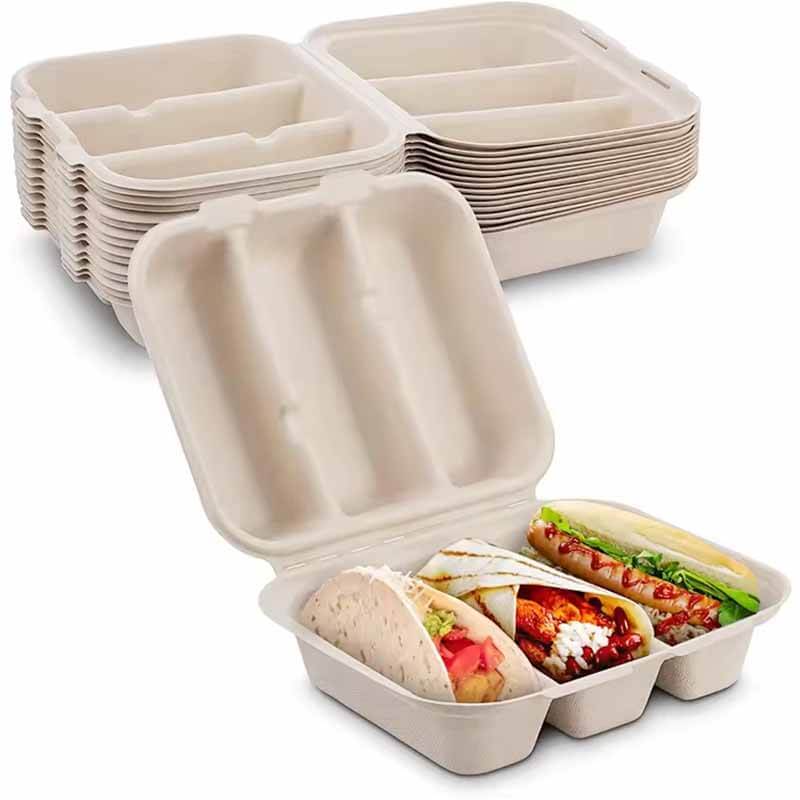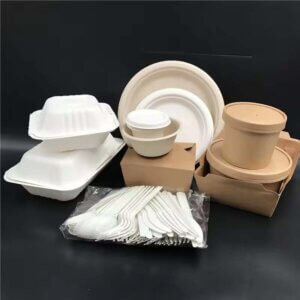Go Green with Biodegradable Food Containers
What are Biodegradable Food Containers?
Characteristics of Biodegradable Food Containers
Biodegradable Containers vs. Compostable Containers vs. Recyclable Containers
What Materials are Used to Produce Biodegradable Food Boxes?
Benefits of Using Biodegradable Food Containers
Types of Biodegradable Food Containers
Advantages of Each Type of Biodegradable Containers
How to Choose the Right Biodegradable Food Container?
In our fast-paced age, anything that can provide convenience is always the first choice. Among them, disposable food containers made of plastic are widely used, which leads to serious environmental pollution problems. These discarded plastic wastes enter into landfills or oceans and take hundreds of years to decompose. In the process of decomposition, they will turn into microplastics and enter the marine system, endangering the ecological environment.
Biodegradable food containers provide the solutions to solve these problems. These containers are made from natural materials, such as plant fibers, cornstarch, and bagasse, they break down quicker and safer than traditional plastic. So, more and more restaurants and food service establishments tend to use eco friendly solutions.

What are Biodegradable Food Containers?
Biodegradable food containers are made from natural materials that can decompose through the action of microorganisms within a short time. Unlike traditional plastic containers, biodegradable containers can return to the earth within a few months to a few years, the decomposition time depends on the specific degradation environment.
Characteristics of Biodegradable Food Containers
Do you know what characteristics the disposable food containers must have to be called biodegradable containers?
- Eco-friendly Materials: The material is from renewable resources, such as plants and agricultural byproducts.
- Decomposition: Can break down into natural elements without leaving toxic residues.
- Durability: Suitable for various food types, including hot food, cold food, liquid food, and solid food.
- Versatility: Available in various forms, including plates, bowls, cups, cutlery, and takeout boxes.
Biodegradable Containers vs. Compostable Containers vs. Recyclable Containers
Biodegradable containers, compostable containers, and recyclable containers are considered as eco friendly food containers, here are the main differences between them.
Biodegradable Containers
- Made from natural materials and can break down into non-toxic components.
- Decomposition time depends on the specific degradation conditions but must be faster than the traditional plastic.
- Don’t have to be in the composting condition to break down, but better conditions can speed up the process.
Compostable Containers
- Can break down into a nutrient-rich soil conditioner.
- Need industrial composting facilities or home composting setups to decompose efficiently.
- Need to meet specific composting standards.
Recyclable Containers
- Made from materials that can be reprocessed and reused.
- These materials may include plastics, glass, metals, and certain types of paper.
- The recycling process depends on the specific situation and generally needs to be sorted and cleaned before processing.

What Materials Are Used to Produce Biodegradable Food Boxes?
The following are the main materials used to make biodegradable food boxes on the market.
- Bamboo: Bamboo fiber containers are durable and suitable for hot and cold food.
- Wheat Straw: Wheat straw fiber containers are also strong and can be used for a variety of food.
- Bagasse: A byproduct of sugarcane processing, the container made by this material is heat resistant, naturally compostable, and fast degrading.
- PLA (Polylactic Acid): Made from the starch in corn kernels, looks like plastic. Can be made into cups, straws, and food packaging and needs industrial composting facilities to break down.
Benefits of Using Biodegradable Food Containers
Now, we encourage both individuals and businesses to convert plastic containers into biodegradable takeout containers, let us have a look at what benefits this container brings to us.
Environmental Benefits
- Reduction in Plastic Pollution: Traditional plastic containers have a huge impact on environmental pollution, and they take centuries to decompose. Switching to biodegradable food containers can reduce plastic waste in landfills and oceans, and reduce microplastics in the ecosystem.
- Decreased Carbon Footprint: Biodegradable containers are made from renewable resources, so they generally need less energy and fewer greenhouse gas emissions compared to the production of plastic containers production.
- Conservation of Natural Resources: Biodegradable takeaway containers are made from the byproduct of agricultural products, so this helps to reduce the need for petroleum. Also, using these materials can encourage farmers to plant more available crops to support the circular economy.
Health Benefits
- Free from Harmful Chemicals: The plastic containers contain BPA (Bisphenol A) and phthalates, these elements will leach into food and pose health risks. But, biodegradable containers are 100% safe and will not release harmful chemicals when they break down.
- Safe for Food Storage and Consumption: Biodegradable food boxes are designed to be safe for food contact. They will not react with food, are generally heat resistant, and are suitable for use in the microwave and oven, which is an ideal choice for serving food and meals.
Economic Benefits
- Long-term Cost Savings: Although the initial cost of the biodegradable takeout containers is higher than the plastic ones, these materials are easy to break down and the business will reduce the cost of waste management. Also, less plastic pollution can lead to fewer health-related issues.
- Supporting Green Businesses: Supporting sustainability and environmental responsibility will encourage other businesses and consumers to embrace these sustainable materials and promote market growth.
Types of Biodegradable Food Containers
After knowing the materials generally used to produce biodegradable carry out containers, let us see the container’s type, because they can be made into various forms.
Biodegradable Plates
Biodegradable plates are made from plant fibers, bagasse, or palm leaves, can be molded into various size sizes and shapes, and generally serve for main courses, appetizers, and desserts.
Biodegradable Bowls
Biodegradable bowls are generally made from the same material as the plate, can be molded into different depths and capacities, ideal for serving soups, salads, and other liquid or semi-liquid foods.
Biodegradable Cups
Biodegradable cups are generally made from PLA, paper coated with PLA, or bagasse, and can be produced in various sizes, and used for hot and cold beverages.
Biodegradable Cutlery
Biodegradable cutlery is made from cornstarch or bamboo, they can be made into forks, knives, and spoons.
Biodegradable Takeout Containers
Biodegradable takeout containers are mainly made from bagasse or other plant fibers. They can be designed with different compartments and sizes, suitable for holding hot, cold, and greasy items.
Advantages of Each Type of Biodegradable Containers
- Plates: Sturdy enough and can hold various foods, especially for large-scale food service operations, using the plates can reduce waste.
- Bowls: Biodegradable bowls are leak-proof and heat-resistant, suitable for serving salads, soup, and other hot dishes.
- Cups: Lightweight, easy to carry, a great replacement for traditional paper cups or plastic cups.
- Cutlery: Sturdy, suitable for takeout usage, and reduces plastic waste when you use disposable cutlery to eat outside.
- Takeout Containers: A great choice for storing pre-prepared meals, they are leak-resistant and can hold various types of food, ensuring the food can arrive in good condition.

How to Choose the Right Biodegradable Food Container?
Due to each food service establishment is different, so you’d better choose the right biodegradable food container according to your specific needs. Here are the factors you can consider:
Type of Food
- Hot Food: We suggest using food containers made from bagasse or bamboo, since they are heat resistant, more durable, and don’t release any harmful chemicals.
- Cold Food: we suggest using PLA or bagasse made food containers to hold cold food, including the salads and sandwiches.
- Liquid Food: The container must leak-proof and sturdy enough, we suggest using bowls made from PLA, bagasse, or coated paper.
- Solid Food: Any biodegradable material is ok.
Duration of Storage
- Short-term Use: For immediate use or same-day consumption, most biodegradable containers will work fine.
- Long-term Storage: If you need to store the food, choose the food container type with a good seal, and the material must freezer safe and microwave-safe.
Compatibility with Microwave and Freezer
- Microwave-Safe: If you need to reheat the food, bagasse containers and PLA containers are widely used.
- Freezer-Safe: If you need to store the food in the refrigerator, bagasse containers will not become brittle or crack due to low temperatures.
Sturdiness and Durability
- Size Fit: Choose containers that are the right size for your portion size. The PLA, bagasse, and bamboo containers are more robust.
- Lid Fit: The lid size needs to fit the container securely to prevent spills.
How to Dispose of Biodegradable Containers Correctly?
Whether you are an individual or a business, you can follow these three points.
Read the Labels
Read the labels and see what is marked, biodegradable, compostable, or both. If the containers you buy are compostable, they can turn into nutrient-rich compost under specific conditions. If the containers you buy are biodegradable, they can decompose naturally over time but are not suitable for composting.
Separate from Non-Biodegradable Waste
If you want to dispose of the biodegradable containers properly, you need to separate them away from trash and recyclables.
Follow Local Guidelines
Learn about local waste management policies, some cities have special bins for compostable and biodegradable waste.
You may also interested in:
9 ways to avoid composting mistakes
FAQs about Biodegradable Containers
Q: Can biodegradable containers be recycled?
A: Biodegradable containers can not be put in the recycling bins, because they can contaminate the recycling stream, they are designed to be disposed of in the biodegradable waste bins.
Q: Can I compost biodegradable containers in my backyard compost bin?
A: Many biodegradable food containers can be composted at home, break them into small pieces and main the compost condition will speed up decomposition.
Q: Are biodegradable and degradable the same?
A: No, biodegradable is completely decomposed into harmless substances such as water, carbon dioxide, and biomass by microorganisms in the natural environment, which is environmentally friendly. However degradable are decompose into smaller parts through physical, chemical, or biological processes, but do not necessarily rely on microorganisms, and the final products may be harmful and potentially pollute the environment.
Making a switch to biodegradable food containers is a small step, but your action will have a positive impact on environmental protection. Eco March is your best partner to go green!

John Q
John Q is Eco March’s Product Manager. With 5 years of prior experience in the food industry after graduating from university, he has been an integral part of Eco March. He excels in creating and developing eco-friendly food packaging products with a keen focus on enhancing the consumer experience.


